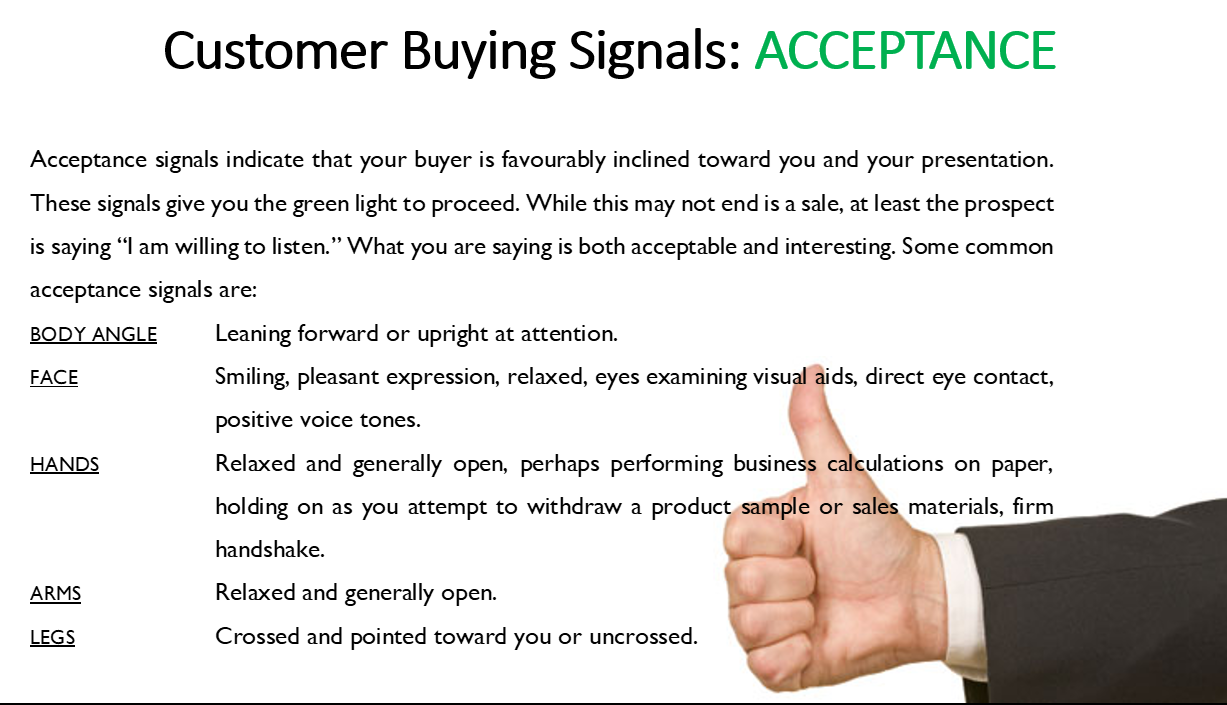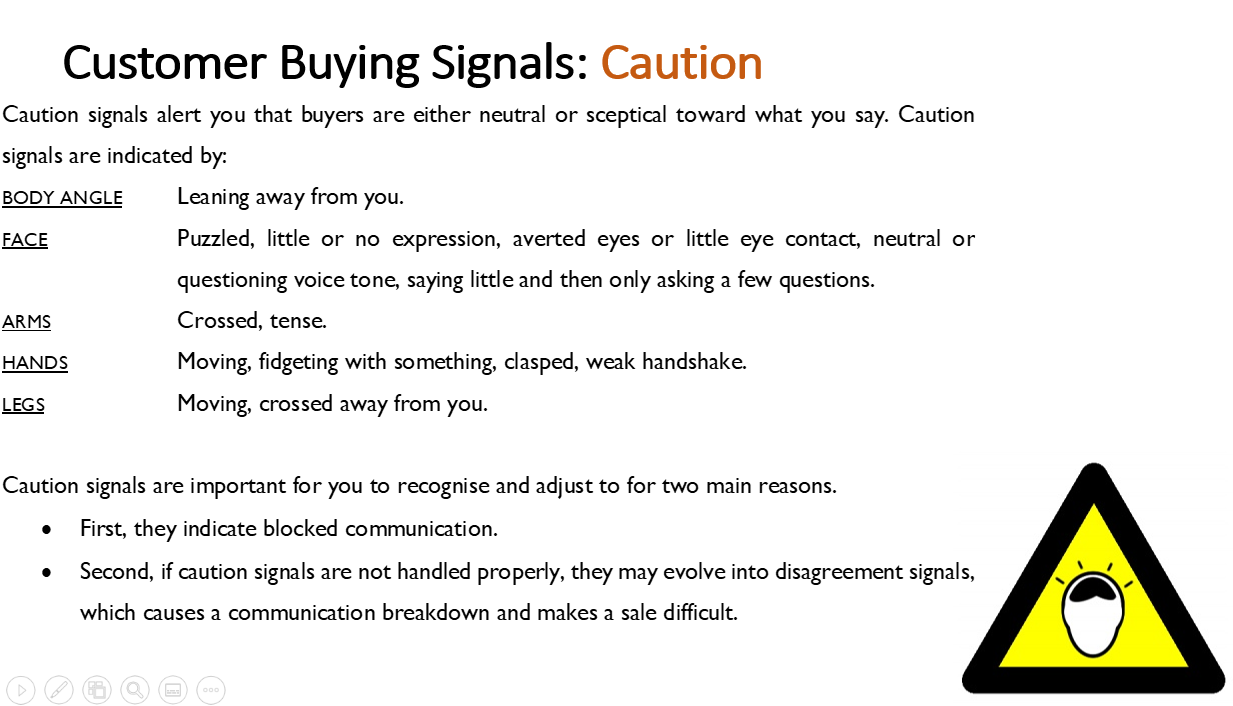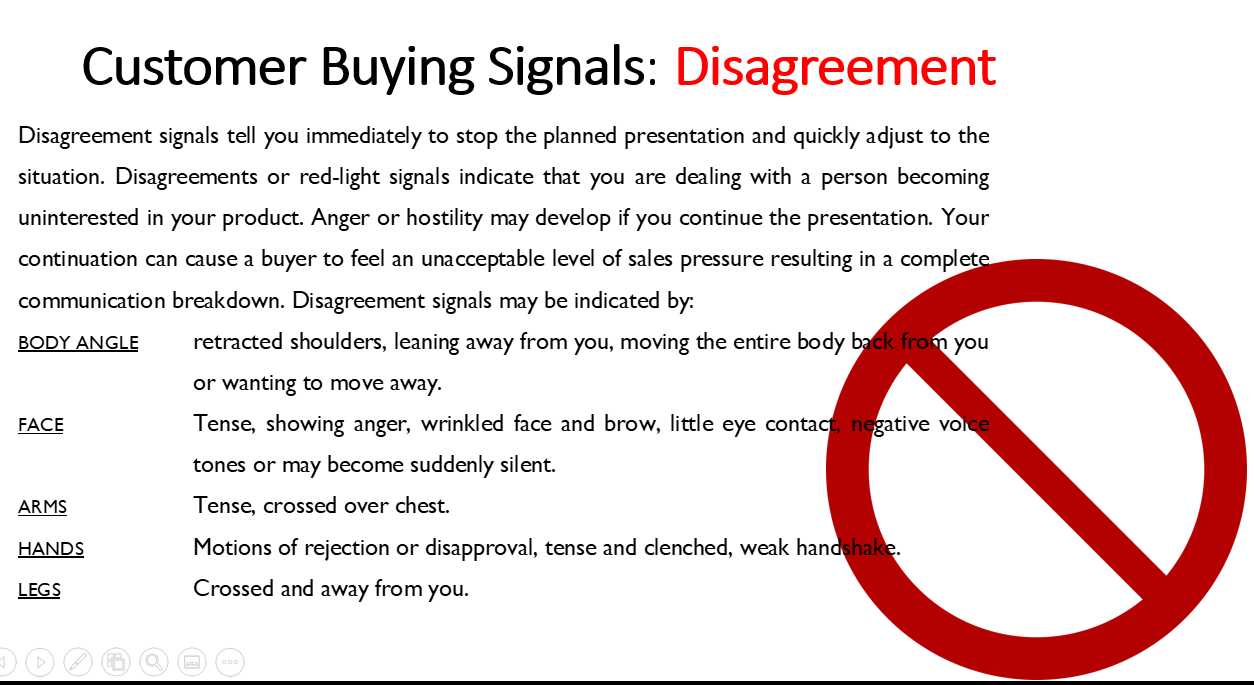To become a better communicator, consider two major elements of communication. First, always strive to improve the message and its delivery in the sales presentation. You need to be a capable encoder. Second, improve your ability to determine what the buyer is communicating to you. Therefore, you need to be a good listener or decoder. A good sales communicator knows how to effectively encode and decode during a presentation.
Salespeople want to be good communicators to persuade people to purchase their products. PERSUASION means the ability to change a person’s belief, position or course of action. The more effective you are at communicating, the greater your chances of being successful at persuasion.
Let’s review several factors to develop persuasive communications.
Let Client Feedback Drive Your Conversation

Learn how to generate feedback to determine whether your listener has received your intended message. Feedback does not refer to any type of listening behaviour by the buyer but a recognisable response from the buyer. A shake of the head, a frown or an effort to say something are all signals to the salesperson. If the salesperson fails to notice or respond to these signals, no feedback can occur, which means faulty or incomplete communication. A salesperson’s observation of feedback is like an auto racer’s glances at the tachometer. Both aid in ascertaining a receiver’s response.
Often, feedback must be sought openly because the prospect does not always give it voluntarily. By interjecting into the presentation questions that require the customer to give a particular response, you can stimulate feedback. Questioning, sometimes called probing, allows the salesperson to determine the buyer’s attitude toward the sales presentation. PROBING refers to gathering information and uncovering customer needs using one or more questions.
The following type of feedback normally forms part of sales training sessions. Sales trainers suggested that salespeople could use questions in their presentations. Some of the questions suggested were:
- Do you think you are paying too much for telecommunications equipment?
- Are you happy with the service now being provided?
- Are you happy with the equipment your present supplier has installed for your company?
These questions were intended to draw negative responses from the customers concerning the relationship with their present supplier. This provided salespeople with a method of determining how the prospect felt about the competitor. These responses allow the salesperson to discuss the specific features, advantages and benefits of their products relative to the products currently used by the prospect.
The use of a question after discussing a benefit is a great method of obtaining feedback. Another way of creating positive feedback is through empathy.
Body Language Gives You Clues
From birth, people learn to communicate their needs, likes and dislikes through nonverbal means. The salesperson can learn from a prospect’s raised eyebrow, a smile, a touch, a scowl or reluctance to make eye contact during a sales presentation. The prospect can communicate with you literally without uttering a word. The ability to interpret these signals is an invaluable tool to the successful sales professional. In conjunction with an interpretation of body language, the salesperson’s skilful use and control of physical actions, gestures and overall body position also are helpful.
The buyer can send nonverbal signals via five communication modes. They are the body angle, facial expression, arm movement or position, hand movements or position and leg position. These modes generally send three types of messages:
- Acceptance
- Caution
- Disagreement
Acceptance Signals

Caution Signals

Proper handling of caution signals requires that you:
- Adjust to the situation by slowing down or departing from your planned presentation.
- Use open-ended questions to encourage your buyers to talk and express their attitudes and beliefs. “Have you ever been interested in improving the efficiency of your workers?” of “What do you think about this benefit?” are examples of open-ended questions.
- Carefully listen to what buyers say and respond directly.
Disagreement Signals
You should handle disagreement signals as you did caution signals by using open-ended questions and by projecting acceptance signals. There are four additional techniques to use. First, stop your planned presentation. There is no use in continuing until you have changed disagreement signals into caution or acceptance signals. Second, temporarily reduce or eliminate any pressure on the person to buy or to participate in the conversation. Let the buyer relax as you slowly move back to your presentation. Third, let your buyer know you are aware that something upsetting has occurred. Show that you are there to help, not to sell at any cost. Finally, use direct questions to determine a buyer’s attitudes and beliefs such as “What do you think of…?” or “Have I said something you do not agree with?”
Empathy Puts you in Your Customer’s Shoes
Empathy is the ability to identify and understand the other person’s feelings, ideas and situation. As a salesperson, you need to be interested in what the buyer is saying – not just in giving a sales presentation. Many of the barriers to communication mentioned earlier can be overcome when you place yourself in the buyer’s shoes. Empathy is saying to a prospect, “I’m here to help you” or “Tell me your problems and needs so I can help you.” Empathy is also evidenced by a salesperson’s display of sincerity and interest in the buyer’s situation.
This may mean acknowledging at times that a prospect may not need your product. Take, for example, the Scott Paper Company salesperson who finds that the customer still has 90% of the paper towels purchased three months ago. There is no reason to sell this customer more paper towels. It is time to help the customer sell the paper towels now on hand by suggesting displays, price reductions and formats for newspaper advertisements. It is always wise to adopt your customer’s point of view to meet the customer’s needs best.
Creating Mutual Trust
Salespeople who develop a mutual, trusting relationship with their customers cannot help be successful. This type of relationship eventually results in high source credibility.
The buyer realised that in the past she was sold products that performed to expectations; the products were worth their price and the salesperson did everything promised. Building mutual trust is important to effective long-run communication.
Listening Clue, You In
HEARING refers to being able to detect sound.
LISTENING is deriving meaning from sounds that are heard. Everything you hear is not worth your undivided attention: for the salesperson, however, listening is a communication skill critical to success.
Salespeople often believe that their job is to talk rather than to listen. If they both talk and listen, their persuasive powers increase. Since people can listen (about 400 words per minute) roughly twice as fast as the average rate of speech, it is understandable that a person’s mind may wander while listening to a salesperson’s presentation or that the salesperson may tune out a prospect. To keep the buyer listening, ask questions, get the buyer involved in the conversation and show visual aids. Once you ask a question, carefully listen to what is said.
Listen between the words for what is not said. Some people reveal more in what they do not say. Part of this is due to the emotional content of the message and part is due to the information they give you. A story illustrates this point.
A salesperson was talking to the president of a large paper mill, “I simply asked him what kind of training he had for his salespeople. He went into a long discourse on all the seminars, training films, videotapes and cassettes they had from the parent company, suppliers, industry associations and in-house programs. I sat, listened and took notes. At the end of his speech, I said to him, “I noticed you did not mention anything about time management for salespeople.” He raised his voice and emphatically said, “You know, just this morning I was talking to a guy and I told him we have to have some time-management training for our salespeople.”
Click here to download and complete the listening ability questionnaire.
